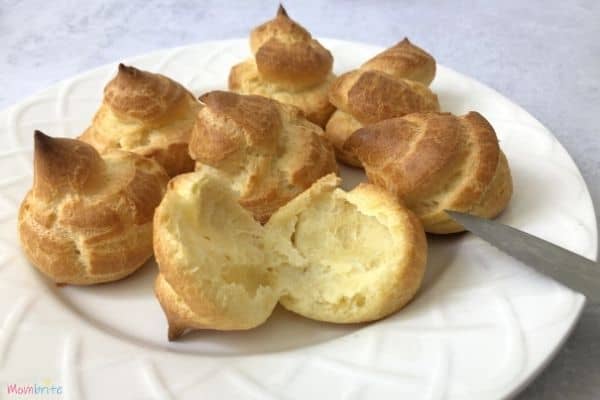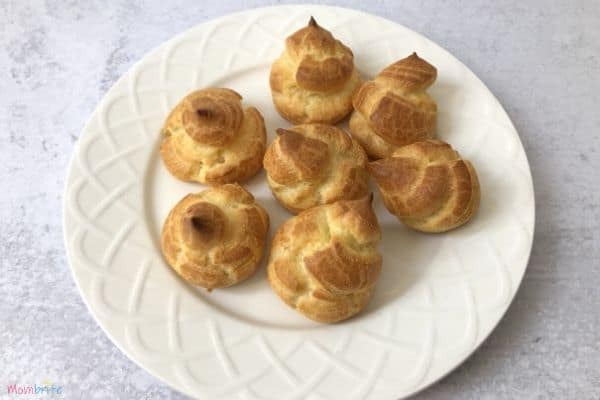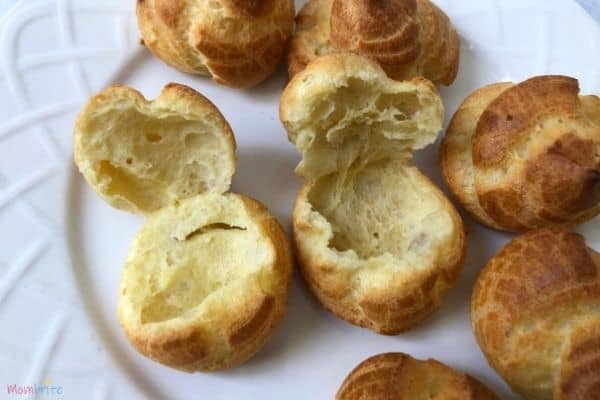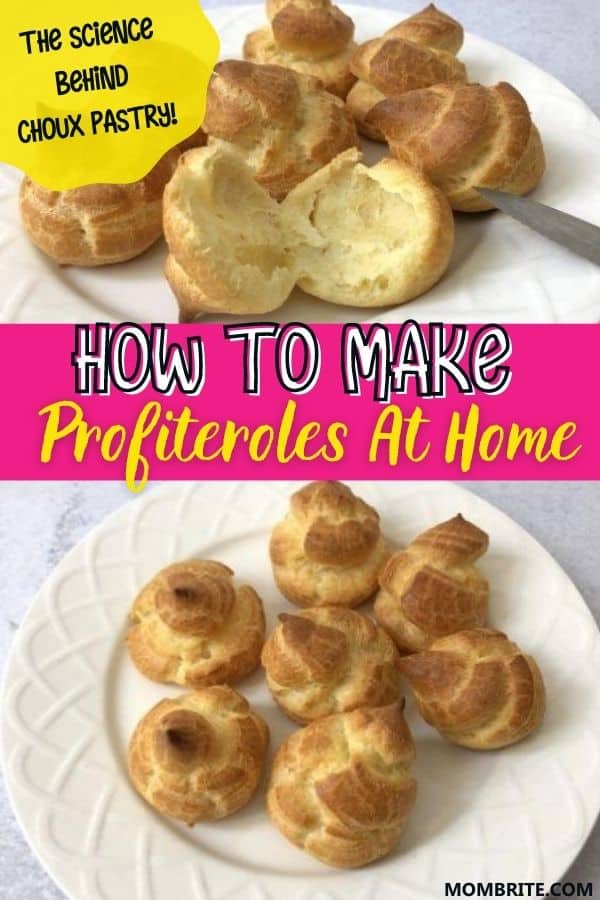You may know the light, cream-filled dessert as cream puffs. Some might call it profiteroles. Whatever you call it, the base of the dessert is choux pastry, or pâte à choux in French. And understanding the science behind choux pastry is the key to baking it successfully.

The most important rule for choux pastry is that you must never, ever open the oven while it bakes. I know how tempting it is to crack open the oven door and take a peek. But doing so will deflate your choux pastry.
A lot of people are afraid to tackle the pâte à choux, but it’s quite simple! Even my kids were able to make their own after I helped them with the initial stovetop part of the baking process.
The great part about choux pastry is that once you master the 1 basic recipe to make the pastry shell, you can now make tons of other pastries. We are talking about delicious desserts like éclairs, beignets, chouquettes, and cream puffs and profiteroles mentioned above.
How to Make Choux Pastry
Ingredients:
- ½ cup unsalted butter
- ½ cup water
- ½ cup milk (2% or whole)
- ¼ teaspoon salt
- 2 teaspoon granulated sugar (optional)
- 1 cup all-purpose flour
- 4 large eggs
- Mixer (handheld or stand)
- Spatula
- Bowls
- Large Ziploc bag
- Parchment paper or baking mats
Note: Instead of ½ cup water and ½ cup milk, you can omit the milk and use 1 cup water. The milk acts as a tenderizer and makes the choux pastry softer and richer.
Instructions:
- Preheat the oven to 400°F (204°C). Line a baking sheet with parchment paper or use baking mats.
- Add butter, water, milk, salt, and sugar (if you want to make the pastry slightly sweet) to a medium saucepan over medium heat. Stir to melt the butter completely.
- Bring the mixture to a full boil and reduce the heat to low.
- Add flour and stir vigorously until the flour is fully combined.
- Mash the dough against the sides and bottom of the pan to gently cook the flour. You know the dough is ready when it pulls away from the sides of the pan to form a ball.
- Transfer the dough to a mixing bowl or bowl of a stand mixer and let it cool for a few minutes.
- Meanwhile, whisk the eggs together in a separate bowl.
- With the handheld mixer or stand mixer running on low speed, slowly add the eggs in 4 separate additions. At first, it might look like the egg doesn’t want to combine with the dough, but as you continue to mix everything will come together into a soft dough.
- Scoop the dough into a large Ziploc bag. You can store it in the fridge for up to 3 days if you don’t want to use it immediately.
- Cut off one corner of the bag.
- Pipe the dough on the parchment paper or baking mat. Tip: Once you finish piping one choux pastry, do not go back to the same one and add more on top. The pastry will not combine together and you will end up with two hollowed-out pastries one on top of another.
- Bake in the oven for 20 minutes.
- WITHOUT opening the oven, reduce the temperature to 350°F (177°C) and bake for an additional 10 minutes.
- Remove from the oven and transfer to a cooling rack.
- Poke a couple of holes in each puff with a toothpick to let the moisture out of the shell and dry out.
- Let the puffs cool completely before filling.

I have tried many different dessert recipes, and as long as you follow the steps exactly, choux pastry is not hard. The only difficult part is being patient and not opening the oven door to take a look at the pastry while baking.
After I took the dough off the oven, my kids were able to help me from that point on. They took turns adding the eggs and turning on the stand mixer. They opened the bag while I filled it with the finished dough. And they had lots of fun piping the dough on the baking mat.
As you can see, they did a wonderful job! If you are hesitant about baking choux pastry, don’t! Even my kids were able to make them! Yes not all of them were perfectly shaped but all of them puffed up and had a pocket inside for fillings.

Science Behind Pâte à Choux
Most pastries require baking soda, baking powder, or yeast for volume. So how do choux pastries puff up without any of those ingredients? Let’s break down the steps to making choux pastry to understand how choux pastry works.
Boiling the butter and water: Bringing the water and butter mixture to a full boil before adding the flour is necessary to provide enough heat for the flour to cook. The flour is what contributes to the structure of the choux pastry. The starch in the flour swells when heated and absorbs the liquid to form the dough.
Adding the eggs: The eggs are the leavening, or rising agent. You want to make sure that the dough cools down before adding the eggs, or else you will end up cooking the eggs. Scrambled eggs in your cream puff, anyone?
The egg yolk acts as an emulsifying agent because they have some amino acids that repel water and some amino acids that attract water. When you combine the egg yolk with the dough, one part of the protein will stick to the water and another will stick to the oil (butter).
Baking the dough: The moisture in the dough forms steam as the puffs bake in the oven. The egg proteins stretch to the point of breaking as the dough stretches to hold the steam. The eggs curdle and then sets in the heat, forming the hollow center.
Conclusion
There are many options when it comes to fillings for the choux pastry. You can cut the puffs open and fill them with whipped cream. You can make creme patissiere (pastry cream) and squeeze it in the puffs with a piping bag. You can also create oblong pastry using the choux dough and make éclairs.
My kids really loved baking the choux pastry and eating them afterward. Since we don’t have desserts often, I let them go to town and with some help from mommy and daddy, we finished the entire batch of cream puffs in a day!
YOU MAY ALSO LIKE:

